Local Plastic Deformation and Quality of Cu-Cu Joints Obtained by Ultrasonic Welding
Abstract
:1. Introduction
2. Materials and Methods
- Fracture load of welded samples;
- Area fraction of bonding or percentage of the fracture surface occupied by microbonds;
- Relative length of well-bonded (defect-free), un-bonded, and partially bonded regions;
- Distribution of normal strains in the cross sections of welded samples.
3. Results
3.1. Lap Shear Strength and Fracture of Joints
3.2. Macro- and Microstructure
4. Discussion
5. Conclusions
- The main finding of the work is that the arrangement of microbonds and the sizes of gaps in joint zones significantly depend on the local strains of the sheets caused by the penetration of tool ridges under the clamping pressure. Joint regions with a linear weld density of more than 70% were observed if the compression strains of the sample exceeded 15%. Tensile strains led to significant degradation of the quality of local bonding; the linear weld density of the joints in certain regions decreased to 5% if the tensile strains of the sample were 5–10%.
- The local normal strains of the samples change periodically. Their values and distribution depend on the mutual positions of ridges of the welding tip and anvil. When the ridges of the welding tip were located directly above the valleys of the anvil, only compression strains of the samples with absolute values of 5–10% were observed. For any other relative arrangement of tool ridges, both the compressive and tensile strains were observed. Their absolute values reached 20 and 17%, respectively, when the ridges of the welding tip were located directly above the ridges of the anvil.
- Normal strains of samples affect the formation of microbonds and their ability to resist the shear load. In the experiments carried out many variants of strain distribution were detected. Therefore, no unambiguous relationship has been found between the shear strength of the joints and average values of the area fraction of bonding and linear weld density.
- It has been concluded that the monitoring of the relative position of the ridges of the welding tip and anvil, as well as the depth of their penetration, is necessary to improve the quality of joints obtained by ultrasonic welding and to reduce the scatter of their strength values.
Author Contributions
Funding
Data Availability Statement
Acknowledgments
Conflicts of Interest
References
- Matheny, M.P.; Graff, K.F. Ultrasonic welding of metals. In Power Ultrasonics-Applications of High-Intensity Ultrasound; Gallego Juárez, J.A., Graff, K.F., Eds.; Woodhead: Cambridge, UK, 2015; pp. 259–293. [Google Scholar]
- Lee, S.S.; Shao, C.; Kim, T.H.; Hu, S.J.; Kannatey-Asibu, E.; Cai, W.W.; Spicer, J.P.; Abell, J.A. Characterization of Ultrasonic Metal Welding by Correlating Online Sensor Signals with Weld Attributes. J. Manuf. Sci. Eng. 2014, 136, 051019. [Google Scholar] [CrossRef]
- Cheng, X.M.; Yang, K.; Wanga, J.; Xiao, W.T.; Huang, S.S. Ultrasonic system and ultrasonic metal welding performance: A status review. J. Manuf. Process. 2022, 84, 1196–1216. [Google Scholar] [CrossRef]
- De Leon, M.; Shin, H.-S. Review of the advancements in aluminum and copper ultrasonic welding in electric vehicles and superconductor applications. J. Mater. Process. Technol. 2022, 307, 117691. [Google Scholar] [CrossRef]
- Ni, Z.L.; Yang, J.J.; Hao, Y.X.; Chen, L.F.; Li, S.; Wang, X.X.; Ye, F.X. Ultrasonic spot welding of aluminum to copper: A review. Int. J. Adv. Manuf. Technol. 2020, 107, 585–606. [Google Scholar] [CrossRef]
- Zhang, C.; Li, H.; Liu, Q.; Huang, C.; Zhou, K. Ultrasonic Welding of Aluminum to Steel: A Review. Metals 2023, 13, 29. [Google Scholar] [CrossRef]
- Sanga, B.; Wattal, R.; Nagesh, D.S. Mechanism of Joint Formation and Characteristics of Interface in Ultrasonic Welding: Literature review. Period. Eng. Nat. Sci. 2018, 6, 107–119. [Google Scholar] [CrossRef]
- Xi, L.; Banu, M.; Hu, S.J.; Cai, W.; Abell, J. Performance Prediction for Ultrasonically Welded Dissimilar Materials Joints. J. Manuf. Sci. Eng. 2017, 139, 011008. [Google Scholar] [CrossRef]
- Ward, A.A.; Zhang, Y.; Cordero, Z.C. Junction growth in ultrasonic spot welding and ultrasonic additive manufacturing. Acta Mater. 2018, 158, 393–406. [Google Scholar] [CrossRef]
- Sanga, B.; Wattal, R.; Nagesh, D.S. An FEA based study of thermal behaviour of ultrasonically welded phosphor bronze sheets. J. Mech. Eng. Sci. 2021, 15, 8057–8071. [Google Scholar] [CrossRef]
- Li, J.; Zillner, J.; Balle, F. In-Depth Evaluation of Ultrasonically Welded Al/Cu Joint: Plastic Deformation, Microstructural Evolution, and Correlation with Mechanical Properties. Materials 2023, 16, 3033. [Google Scholar] [CrossRef]
- Hopkins, C.D.; Wolcott, P.J.; Dapino, M.J.; Truog, A.G.; Babu, S.S.; Fernandez, S.A. Optimizing Uitrasonic Additive Manufactured Al 3003 Properties with Statisticai Modeiing. J. Eng. Mater. Technol. 2012, 134, 011004. [Google Scholar] [CrossRef]
- Lee, S.S.; Kim, T.H.; Hu, S.J.; Cai, W.W.; Li, J.; Abell, J.A. Characterization of Joint Quality in Ultrasonic Welding of Battery Tabs. J. Manuf. Sci. Eng. 2013, 135, 021004. [Google Scholar] [CrossRef]
- Mukhametgalina, A.A.; Murzinova, M.A.; Nazarov, A.A. Weld Quality and Microstructure Development in Ultrasonically Welded Titanium Joints. Metall. Mater. Trans. A 2022, 53, 1119–1131. [Google Scholar] [CrossRef]
- Zhang, C.Y.; Chen, D.L.; Luo, A.A. Joining 5754 automotive aluminum alloy 2-mm-thick sheets using ultrasonic spot welding. Weld. J. 2014, 93, 131–138. [Google Scholar]
- Yang, J.; Cao, B.; Lu, Q. The Effect of Welding Energy on the Microstructural and Mechanical Properties of Ultrasonic-Welded Copper Joints. Materials 2017, 10, 193. [Google Scholar] [CrossRef]
- Müller, F.W.; Schiebahn, A.; Reisgen, U. Quality prediction of disturbed ultrasonic metal welds. J. Adv. Join. Process. 2022, 5, 100086. [Google Scholar] [CrossRef]
- Satpathy, M.P.; Moharana, B.R.; Dewangan, S.; Sahoo, S.K. Modeling and optimization of ultrasonic metal welding on dissimilar sheets using fuzzy based genetic algorithm approach. Eng. Sci. Technol. Int. J. 2015, 18, 634–647. [Google Scholar] [CrossRef]
- Müller, F.W.; Chen, C.Y.; Schiebahn, A.; Reisgen, U. Application of electrical power measurements for process monitoring in ultrasonic metal welding. Weld World 2023, 67, 395–415. [Google Scholar] [CrossRef]
- Faes, K.; Nunes, R.; De Meester, S.; De Waele, W.; Rubino, F.; Carlone, P. Influence of the Process Parameters on the Properties of Cu-Cu Ultrasonic Welds. J. Manuf. Mater. Process. 2023, 7, 19. [Google Scholar] [CrossRef]
- De Leon, M.; Shin, H.-S. Weldability assessment of Mg alloy (AZ31B) sheets by an ultrasonic spot welding method. J. Mater. Process. Technol. 2017, 243, 1–8. [Google Scholar] [CrossRef]
- Peng, H.; Chen, D.; Jiang, X. Microstructure and Mechanical Properties of an Ultrasonic Spot Welded Aluminum Alloy: The Effect of Welding Energy. Materials 2017, 10, 449. [Google Scholar] [CrossRef] [PubMed]
- Chen, K.K.; Zhang, Y.S.; Wang, H.Z. Study of plastic deformation and interface friction process for ultrasonic welding. Sci. Technol. Weld. Join. 2016, 22, 208–216. [Google Scholar] [CrossRef]
- Ma, Z.; Zhang, Y. Characterization of multilayer ultrasonic welding based on the online monitoring of sonotrode displacement. J. Manuf. Process. 2020, 54, 138–147. [Google Scholar] [CrossRef]
- Lu, Y.; Song, H.; Taber, G.A.; Foster, D.R.; Daehn, G.S.; Zhang, W. In-situ measurement of relative motion during ultrasonic spot welding of aluminum alloy using Photonic Doppler Velocimetry. J. Mater. Process. Technol. 2016, 231, 431–440. [Google Scholar] [CrossRef]
- Li, H.; Cao, B.; Liu, J.; Yang, J. Modeling of high-power ultrasonic welding of Cu/Al joint. Int. J. Adv. Manuf. Technol. 2018, 97, 833–844. [Google Scholar] [CrossRef]
- Balz, I.; Abi Raad, E.; Rosenthal, E.; Lohoff, R.; Schiebahn, A.; Reisgen, U.; Vorlander, M. Process monitoring of ultrasonic metal welding of battery tabs using external sensor data. J. Adv. Join. Process. 2020, 1, 10005. [Google Scholar] [CrossRef]
- Arimoto, K.; Sasaki, T.; Doi, Y.; Kim, T. Ultrasonic Bonding of Multi-Layered Foil Using a Cylindrical Surface Tool. Metals 2019, 9, 505. [Google Scholar] [CrossRef]
- Shin, S.; Nam, S.; Yu, J.; Park, J.; Kim, D. Ultrasonic Metal Welding of Multilayered Copper Foils to Nickel-Plated Copper Sheet in Lithium-Ion Battery Cell. Metals 2021, 11, 1195. [Google Scholar] [CrossRef]
- Ye, F.; Wang, Y.; Lu, H.; Guo, Y. Study on the bonding mechanism of multilayer copper with nickel sheet in ultrasonic welding process. Mater. Res. Express 2022, 9, 026527. [Google Scholar] [CrossRef]
- Qi, H.; Ye, F.; Lu, H. Visualization of plastic flow in metal ultrasonic welding by adding interlayer. J. Manuf. Process. 2022, 83, 571–575. [Google Scholar] [CrossRef]
- Bakavos, D.; Prangnell, P.B. Mechanisms of joint and microstructure formation in high power ultrasonic spot welding 6111 aluminium automotive sheet. Mater. Sci. Eng. A 2010, 527, 6320–6334. [Google Scholar] [CrossRef]
- Dhara, S.; Das, A. Impact of ultrasonic welding on multi-layered Al–Cu joint for electric vehicle battery applications: A layer-wise microstructural analysis. Mater. Sci. Eng. A 2020, 791, 139795. [Google Scholar] [CrossRef]
- Shen, N.; Samanta, A.; Cai, W.W.; Rinker, T.; Carlson, B.; Ding, H. 3D finite element model of dynamic material behaviors for multilayer ultrasonic metal welding. J. Manuf. Process. 2021, 62, 302–312. [Google Scholar] [CrossRef]
- Shayakhmetova, E.R.; Murzinova, M.A.; Zadorozhniy, V.S.; Nazarov, A.A. Microstructure of samples processed by ultrasonic consolidation of nickel sheets. Metals 2022, 12, 1865. [Google Scholar] [CrossRef]
- Humphreys, F.J. Characterisation of fine-scale microstructures by electron backscatter diffraction (EBSD). Scr. Mater. 2004, 51, 771–776. [Google Scholar] [CrossRef]
- Humphreys, F.J. Review Grain and subgrain characterisation by electron backscatter diffraction. J. Mater. Sci. 2001, 36, 3833–3854. [Google Scholar] [CrossRef]
- BS EN 1465:2009; Adhesives - Determination of Tensile Lap-Shear Strength of Bonded Assemblies. International Organization for Standardization (IS0): Brussels, Belgium, 2009.
- Ervin, E. Quantitative metallography. In ASM Handbook: Metallography and Microstructures; ASM International: Materials Park, OH, USA, 1998; Volume 9, pp. 187–220. [Google Scholar]
- Friel, R.J.; Johnson, K.E.; Dickens, P.M.; Harris, R.A. The effect of interface topography for Ultrasonic Consolidation of aluminium. Mater. Sci. Eng. A 2010, 527, 4474–4483. [Google Scholar] [CrossRef]
- Kaibyshev, O.A.; Lutfullin, R.Y.; Berdin, V.K. The effect of superplasticity on the solid state weldability of the titanium alloy Ti-4.5A1-3Mo-1V. Acta Metall. Mater. 1994, 42, 2609–2615. [Google Scholar] [CrossRef]
- Zhu, X.; Byrne, J.G. Effect of Interface Defects on the Mechanical Properties of Autogenous Diffusion Bonded Joints. J. Mater. Eng. 1991, 13, 207–211. [Google Scholar] [CrossRef]
- Abramoff, M.; Magelhaes, P.J.; Ram, S.J. Image Processing with ImageJ. Biophotonics Int. 2004, 11, 36–42. [Google Scholar]
- Su, Z.; Zhu, Z.; Zhang, Y.; Zhang, H.; Xiao, Q. Recrystallization Behavior of a Pure Cu Connection Interface with Ultrasonic Welding. Metals 2021, 11, 61. [Google Scholar] [CrossRef]
- Ma, Q.; Ma, J.; Zhou, J.; Zheng, X.; Ji, H. Dislocation behavior in Cu single crystal joints under the ultrasonically excited high-strain-rate deformation. J. Mater. Sci. Technol. 2023, 141, 66–77. [Google Scholar] [CrossRef]
- Ma, Q.; Cao, Y.; Zhang, W.; Zhao, W.; Chen, H.; Li, M.; Liang, Z.; Xiao, Y.; Ji, H. Low energy ultrasonic welding for Cu-Cu joining accelerated via Cu nanoparticles. J. Mater. Process. Technol. 2021, 296, 117210. [Google Scholar] [CrossRef]
- Shen, N.; Samanta, A.; Ding, H.; Ding, H.; Cai, W.W. Simulating microstructure evolution of battery tabs during ultrasonic welding. J. Manuf. Process. 2016, 23, 306–314. [Google Scholar] [CrossRef]
- Thompson, A.W. Substructure Strengthening Mechanisms. Metall. Trans. A 1977, 8, 833–842. [Google Scholar] [CrossRef]
- Hall, E.O. Deformation and ageing of mild steel: III Discussion of Results. Proc. Phys. Soc. 1951, 64, 747–753. [Google Scholar] [CrossRef]
- Petch, N.J. The cleavage strength of polycrystals. J. Iron Steel Inst. 1953, 174, 25–28. [Google Scholar]
- Ni, Z.L.; Ma, J.S.; Liu, Y.; Li, B.H.; Wang, X.X.; Ye, F.X. Microstructure evolution and mechanical property strengthening mechanisms of Cu/Cu NPs/Cu joint fabricated by ultrasonic spot welding. Mater. Sci. Eng. A 2023, 866, 144656. [Google Scholar] [CrossRef]
- Al-Sarraf, Z.S. A Study of Ultrasonic Metal Welding. Ph.D. Thesis, University of Glasgow, Glasgow, UK, 2013. Available online: http://theses.gla.ac.uk/4375/ (accessed on 1 August 2023).
- Shayakhmetova, E.R.; Mukhametgalina, A.A.; Murzinova, M.A.; Nazarov, A.A. Study of solid state joints of copper processed by ultrasonic welding. Mater. Phys. Mech. 2021, 47, 569–576. [Google Scholar] [CrossRef]
- Ni, Z.L.; Liu, Y.; Wang, Y.H.; He, B.Y. Interfacial bonding mechanism and fracture behavior in ultrasonic spot welding of copper sheets. Mater. Sci. Eng. A 2022, 833, 142536. [Google Scholar] [CrossRef]
- Ma, Q.; Ma, J.; Zhou, J.; Ji, H. Intrinsic dependence of welding quality and recrystallization on the surface-contacted micro-asperity scale during ultrasonic welding of Cu–Cu joints. J. Mater. Res. Technol. 2022, 17, 353–364. [Google Scholar] [CrossRef]
- Yang, J.; Ni, Z.; Nazarov, A.A.; Ye, F. Effect of Alcohol on the Mechanical and Electrical Properties of Ultrasonic Spot Welded Cu/Cu Joints. Metals 2023, 13, 21. [Google Scholar] [CrossRef]
- Zhao, D.; Jiang, C.; Zhao, K. Ultrasonic welding of AZ31B magnesium alloy and pure copper: Microstructure, mechanical properties and finite element analysis. J. Mater. Res. Technol. 2023, 23, 1273–1284. [Google Scholar] [CrossRef]
- Chen, K.; Zhang, Y. Mechanical analysis of ultrasonic welding considering knurl pattern of sonotrode tip. Mater. Des. 2015, 87, 393–404. [Google Scholar] [CrossRef]
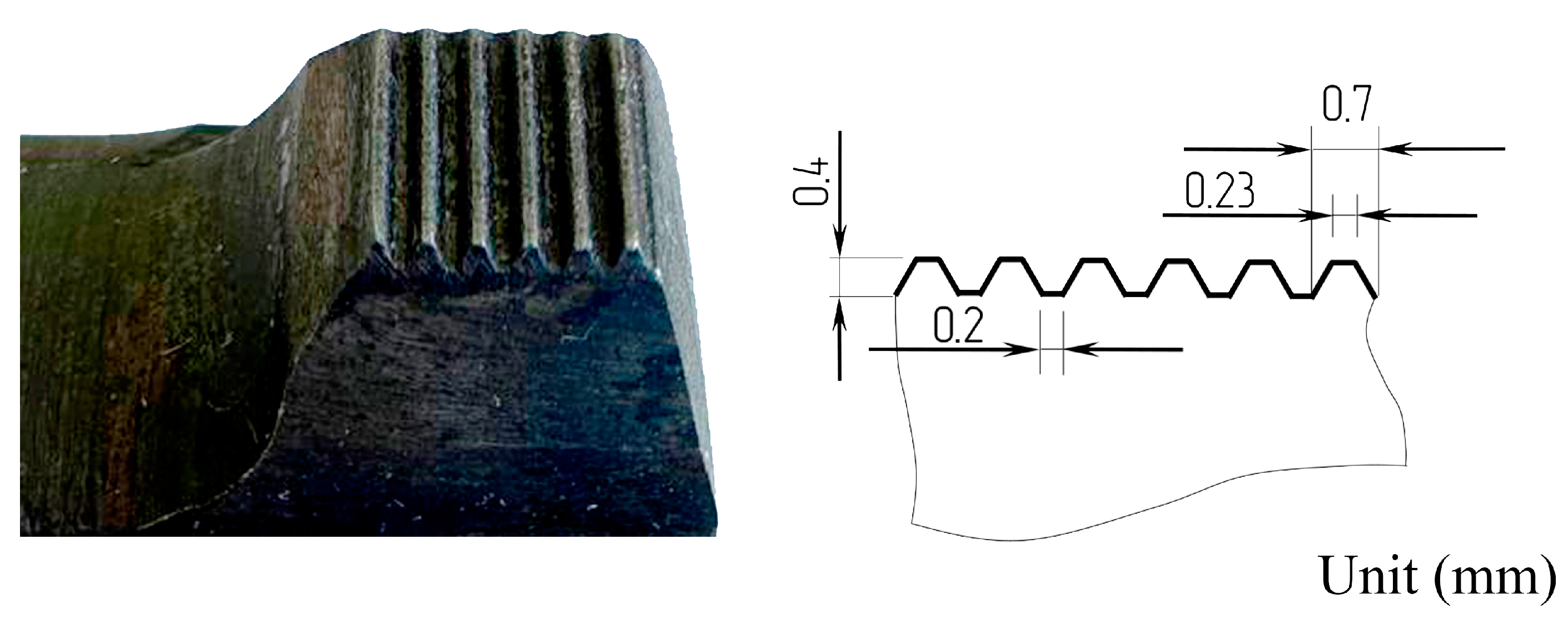


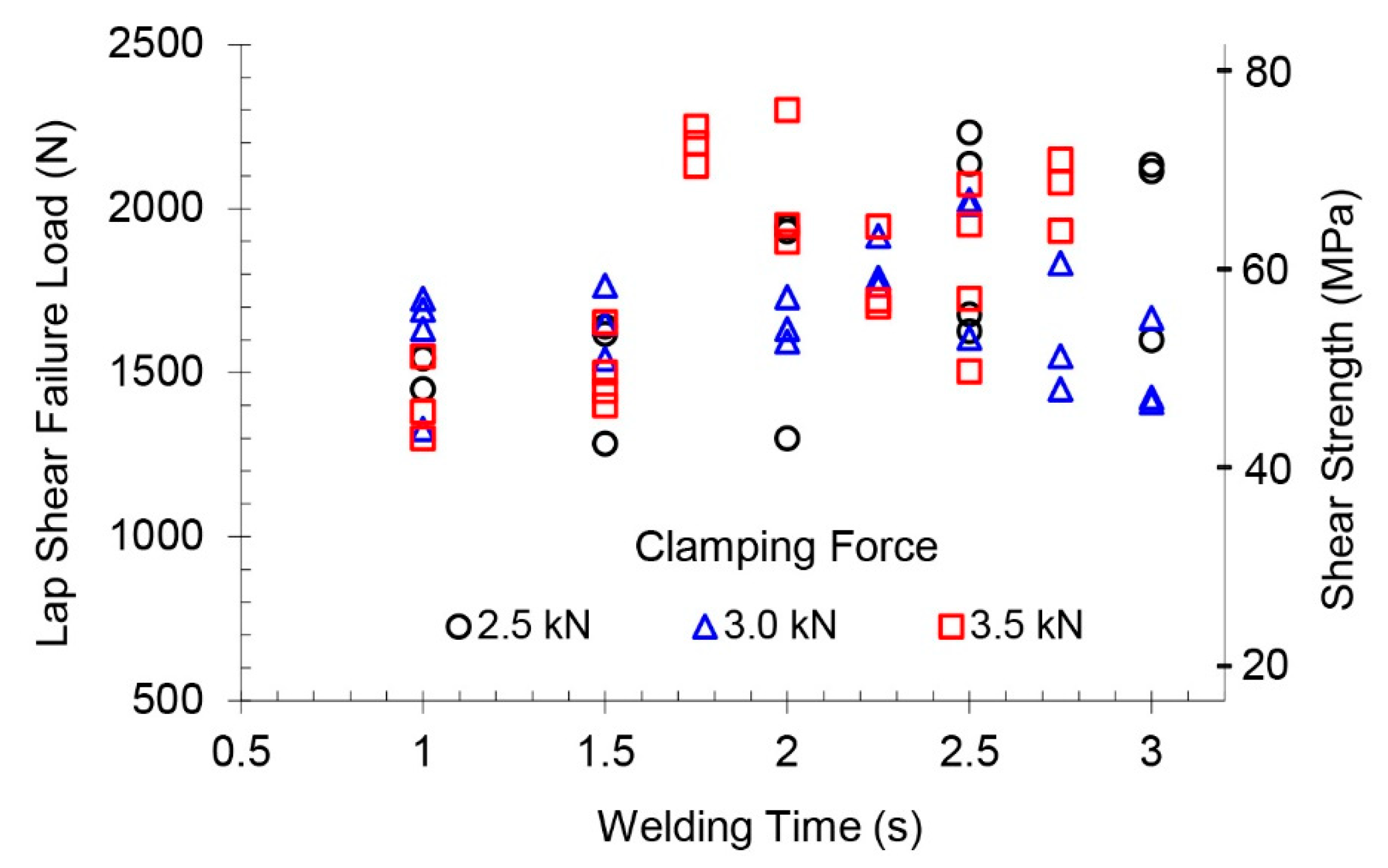
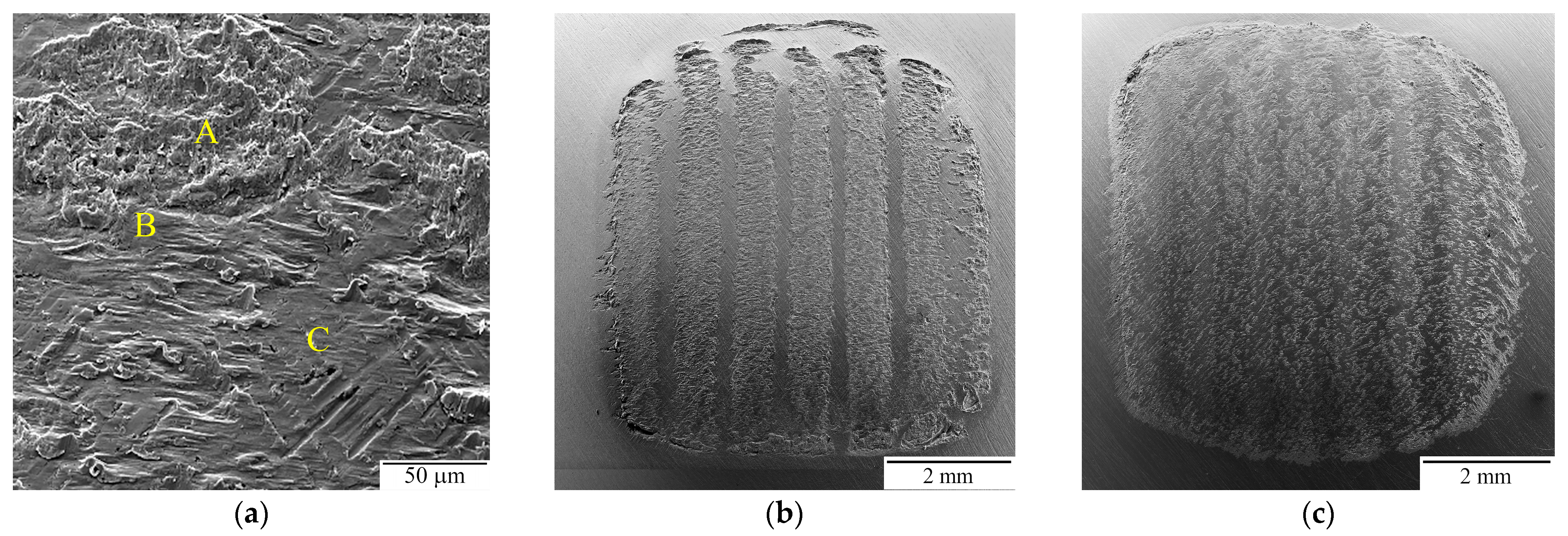

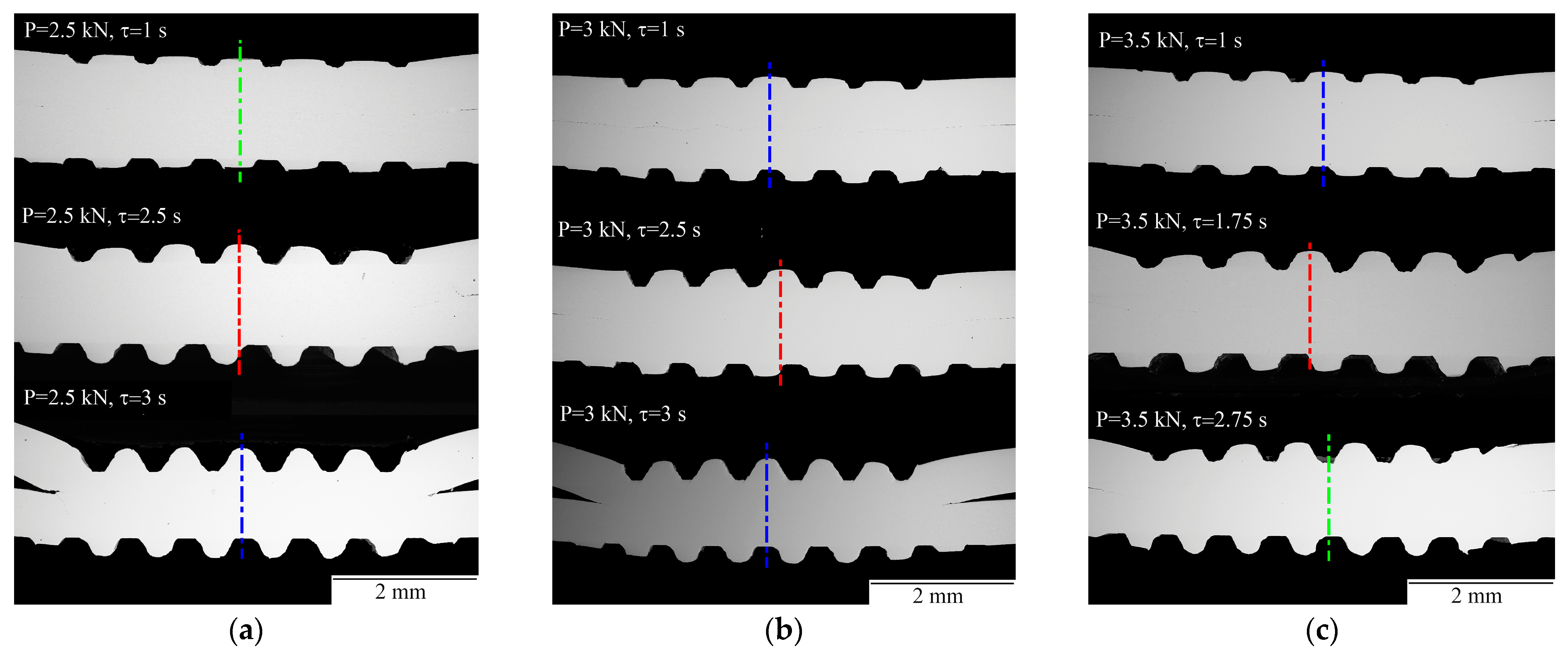





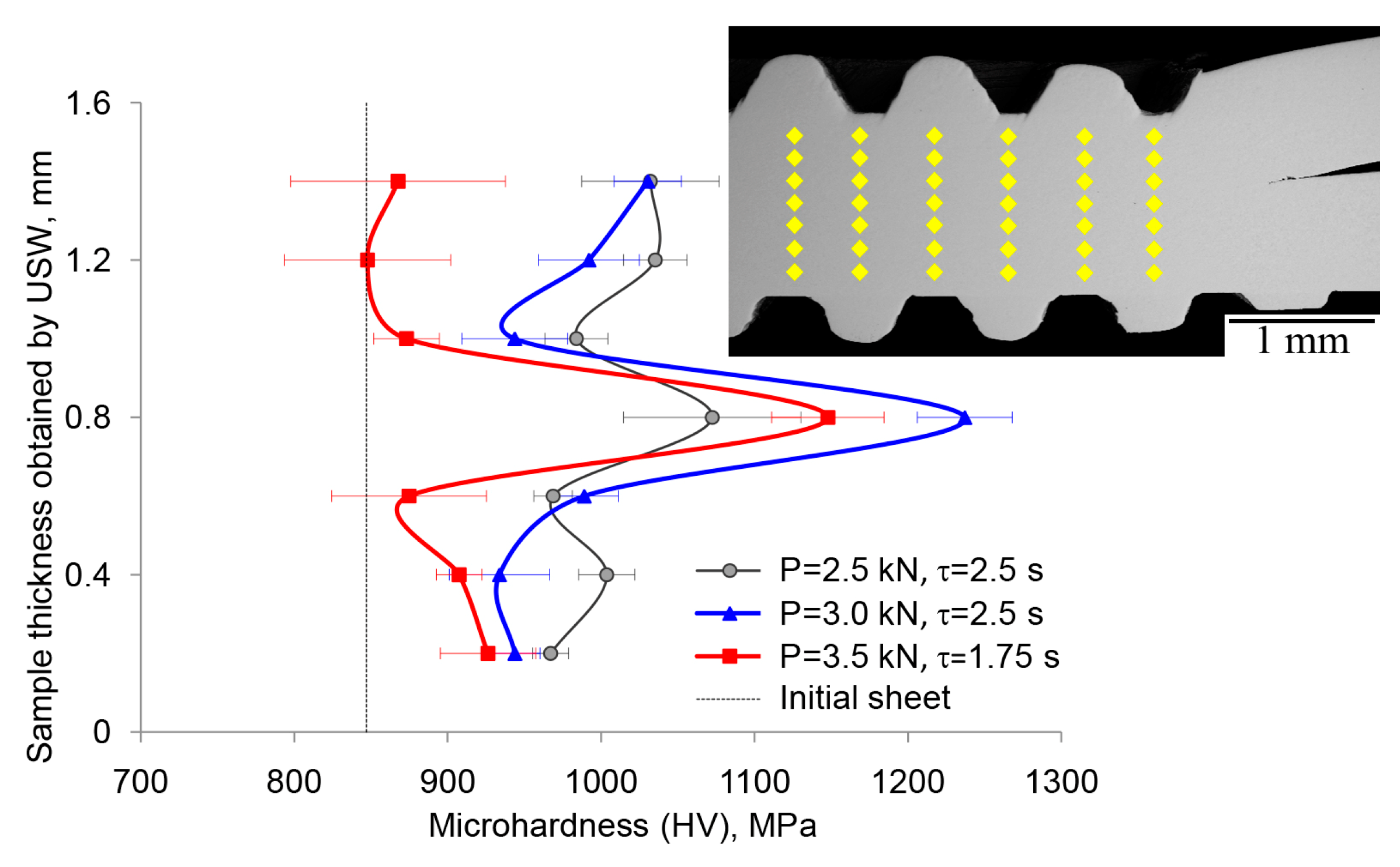

| Clamping Force, kN | 2.5 | 3.0 | 3.5 | ||||||
| Welding Time, s | 1 | 2.5 | 3 | 1 | 2.5 | 3 | 1 | 1.75 | 2.75 |
| Average Failure Load, N | 1512 ± 55 | 1918 ± 311 | 1950 ± 303 | 1594 ± 181 | 1824 ± 80 | 1500 ± 145 | 1410 ± 128 | 2193 ± 60 | 2054 ± 111 |
| Coefficient of variation, % | 3.6 | 16.2 | 15.5 | 11.4 | 4.4 | 9.6 | 9.0 | 2.7 | 5.4 |
| Sheet Thickness, mm | Time, s/Energy, J | Clamping Force, N | The Highest Tensile Shear Force, N | * Shear Strength, MPa | Failure Mode | Ref. |
|---|---|---|---|---|---|---|
| 0.8/0.8 | 1.75 s | 3500 | 2300 | 76 | Interface mode | This work |
| 0.1/0.1 0.5/0.5 | - - | 700 750 | 870 700 | 30 25 | Interface mode Nugget pull-out | [52] |
| 0.8/0.8 | 1600 J 2000 J | 2350 | 4200 4300 | 120 123 | Interface mode Nugget pull-out | [16] |
| 0.5/0.5 | 700 J 1000 J | - | 1900 2200 | 48 55 | Interface mode Nugget pull-out | [46] |
| 0.8/0.8 | 2 s | 3500 | 700 | 36 | Interface mode | [53] |
| 0.5/1 | 0.7 s 0.8 s | 1813 1813 | 2100 2370 | 34 38.5 | Interface mode Nugget pull-out | [54] |
| 1/1 | 0.8/2000 | - | 2200 | 55 | Interface mode | [55] |
| 0.5/1 | 0.6 s | 2040 2490 | 1478 1724 | 24 28 | Interface mode Nugget pull-out | [56] |
| 1/1 | 1.2/2500 | 2500 | 5500 | 86 | - | [17] |
Disclaimer/Publisher’s Note: The statements, opinions and data contained in all publications are solely those of the individual author(s) and contributor(s) and not of MDPI and/or the editor(s). MDPI and/or the editor(s) disclaim responsibility for any injury to people or property resulting from any ideas, methods, instructions or products referred to in the content. |
© 2023 by the authors. Licensee MDPI, Basel, Switzerland. This article is an open access article distributed under the terms and conditions of the Creative Commons Attribution (CC BY) license (https://creativecommons.org/licenses/by/4.0/).
Share and Cite
Murzinova, M.A.; Shayakhmetova, E.R.; Mukhametgalina, A.A.; Sarkeeva, A.A.; Nazarov, A.A. Local Plastic Deformation and Quality of Cu-Cu Joints Obtained by Ultrasonic Welding. Metals 2023, 13, 1661. https://doi.org/10.3390/met13101661
Murzinova MA, Shayakhmetova ER, Mukhametgalina AA, Sarkeeva AA, Nazarov AA. Local Plastic Deformation and Quality of Cu-Cu Joints Obtained by Ultrasonic Welding. Metals. 2023; 13(10):1661. https://doi.org/10.3390/met13101661
Chicago/Turabian StyleMurzinova, Mariya A., Elvina R. Shayakhmetova, Aygul A. Mukhametgalina, Aygul A. Sarkeeva, and Ayrat A. Nazarov. 2023. "Local Plastic Deformation and Quality of Cu-Cu Joints Obtained by Ultrasonic Welding" Metals 13, no. 10: 1661. https://doi.org/10.3390/met13101661





